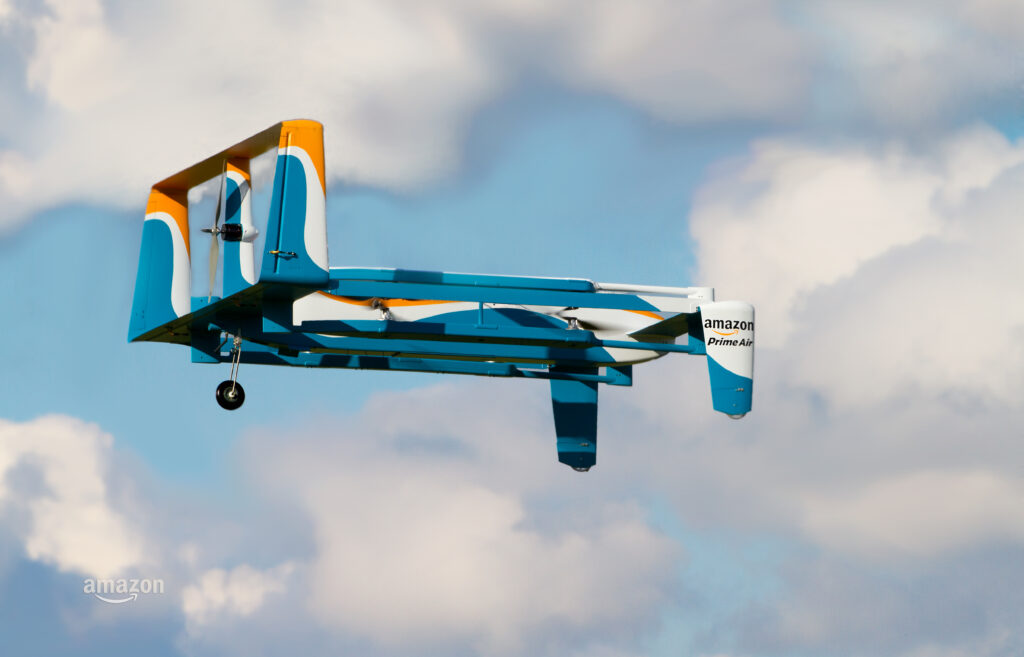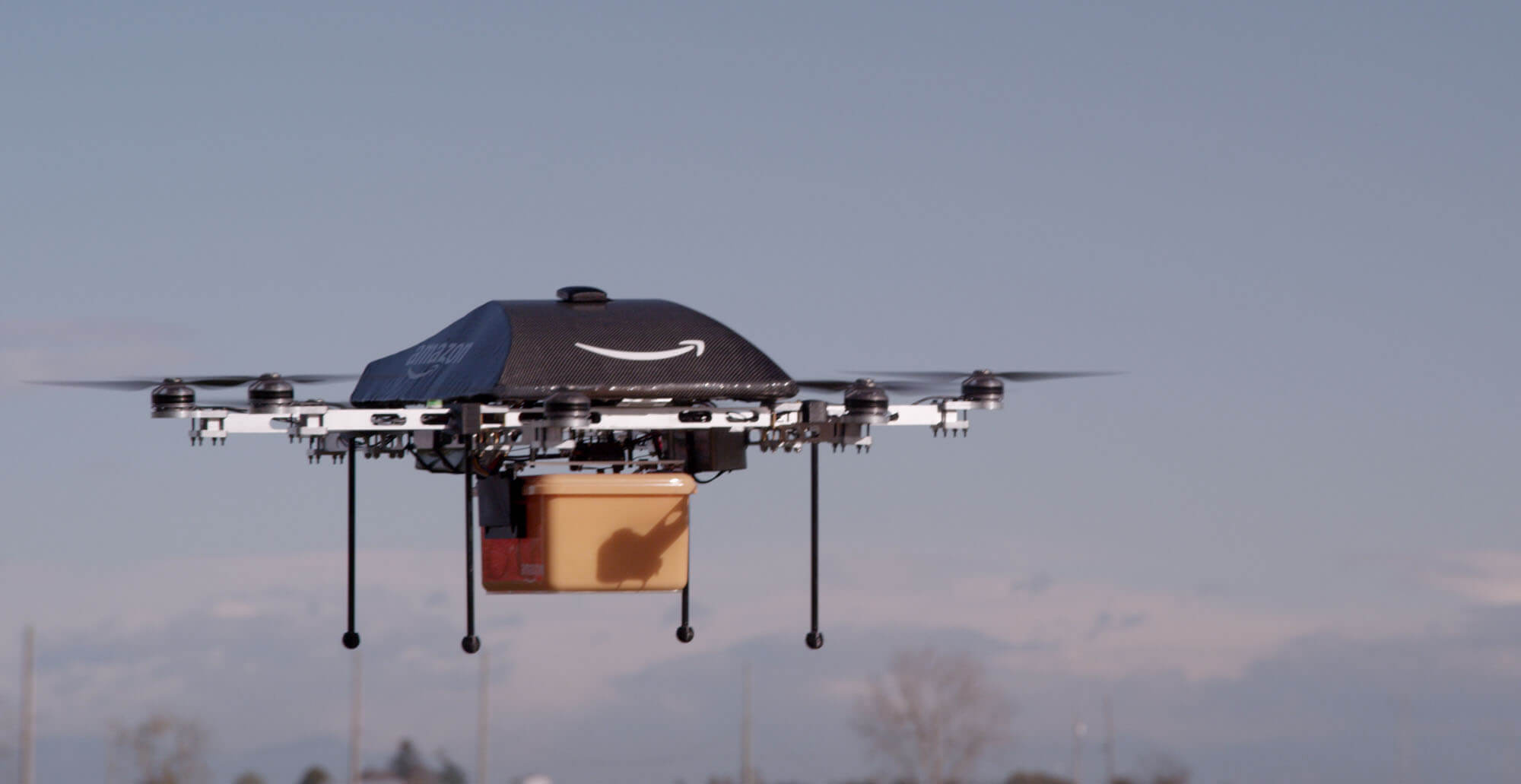The short answer is that Amazon doesn’t “get around” Beyond Visual Line of Sight (BVLOS), no one does. Amazon is subject to the same CIvil Aviation Authority (CAA) regulations worldwide as everyone else. While we can’t go behind-the-scenes on what’s happening at Amazon HQ, we can explain what is public knowledge and speculate at some of their major considerations and challenges.
Prime Air is the branch of Amazon overseeing drone delivery operations, which they describe on their website as, “a future delivery system from Amazon designed to safely get packages to customers in 30 minutes or less using unmanned aerial vehicles, also called drones.”
In June 2019, Amazon revealed their latest Prime Air package delivery drone design at their re:MARS Conference (Machine Learning, Automation, Robotics and Space), with the statement, “we expect to scale Prime Air both quickly and efficiently, delivering packages via drone to customers within months.”
To date, this has not happened. The reason for this is a bit complicated and is largely due to the regulatory path that is required for drone deliveries versus flying a drone recreationally.
The reality around drone deliveries is that the technology exists—there are many companies out there who already have or are currently developing new unmanned aircraft designs that are capable of drone deliveries, but the barriers to actually starting a drone delivery service are regulatory rather than technological in nature.
In general, the regulatory path for a drone delivery platform to obtain a BVLOS approval starts with a Part 135 certification, AKA the Air Carrier and Operator certification. This is because drone delivery services would likely carry payloads of over 55 pounds, which is the upper limit for a Part 107 certification (the certification required to operate commercial drones), as well as carry payloads that do not belong to them, for compensation. The Part 135 certification is what airlines use—essentially, a company wanting to offer drone deliveries should think of themselves as an airline and have the similar rigor of care and preparedness that an aviation company would have. The nature of this certification is that it is much more rigorous and harder to obtain than a Part 107.
In order to operate under BVLOS rules, the air carrier would need to obtain a BVLOS exemption under Part 135. This can be an even more stringent set of standards compared to Part 107. The FAA does recognize the limitations around Part 107 and is open to businesses applying for exemptions under Part 135 instead. Examples of such exemptions include rules for seatbelts, crew rest breaks, maintenance of aircraft, training, documentation, etc.
Regardless of whether a Part 107 or Part 135 application pathway is chosen, a Detect-and-Avoid system is a critical part of the safety mechanisms required when applying for a BVLOS exemption. Amazon uses onboard Detect-and-Avoid technology that shares attributes similar to the Iris CASIA computer vision system and this is a part of their Part 135 exemption application, demonstrating the fact that Detect-and-Avoid capability is critical to universal BVLOS adoption across regulatory frameworks. The fact that Amazon spent significant resources to develop their own Detect-and-Avoid system using sensors and algorithms is evidence that no one can get around a BVLOS exemption without this critical technology.
Amazon has already submitted their application for an exemption under Part 135, but have yet to obtain the approval (although they applied earlier than UPS). The reason for this is that Amazon is seeking a different path to attaining an exemption, i.e. seeking an exemption from providing an airworthiness certification for their drone design as well as a UAS operating exemption. This added complication is likely the reason for their delays in obtaining the approvals. However, given that their application includes Detect-and-Avoid technology as a component of their safety mechanisms, it is likely that they’re on the right path to obtaining approval soon.
What is Part 135?
According to the FAA website,
“The FAA is encouraging innovation through the Unmanned Aircraft Systems (UAS) Integration Pilot Program (IPP) by working with industry, state, local, and tribal governments to realize the benefits of drones, while informing future rules and regulations.
Participants in these programs are among the first to prove their concepts, including package delivery by drone through part 135 air carrier certification. Part 135 certification is the only path for small drones to carry the property of another for compensation beyond visual line of sight.
As participants in these programs move to prove their concepts, they must use FAA’s existing Part 135 certification process, some of which FAA has adapted for drone operations by granting exemptions for rules that don’t apply to drones, such as the requirement to carry the flight manuals on board the aircraft.”
The FAA website states that Part 135 certificates were issued to Wing Aviation in April 2019 and UPS Flight Forward, Inc. in September 2019. Amazon is not listed, but is undoubtedly one of the “six additional part 135 air carrier certificate applications that have been submitted by IPP operators” that the FAA is working on.
In July of 2019 Amazon sent a 29-page letter to the FAA requesting “to operate as a Part 135 unmanned air carrier to conduct commercial drone deliveries in the United States., and also requests a number of waivers, including allowing the company to use aircraft that don’t yet have an airworthiness certificate.”
At this time of writing Amazon does not currently appear to be conducting BVLOS operations, at least not with sanctioned permissions from the FAA. It is expected that they will obtain their Part 135 exemption approvals in 2020.

Sources
https://www.amazon.com/Amazon-Prime-Air/b?ie=UTF8&node=8037720011
https://www.faa.gov/uas/advanced_operations/package_delivery_drone/
https://www.bizjournals.com/washington/news/2019/08/04/amazons-latest-delivery-drone-has-fail-safe-logic.html
https://uavcoach.com/part-135-first-year/
What can we learn from Amazon and UPS’ latest regulatory filings with the FAA?

